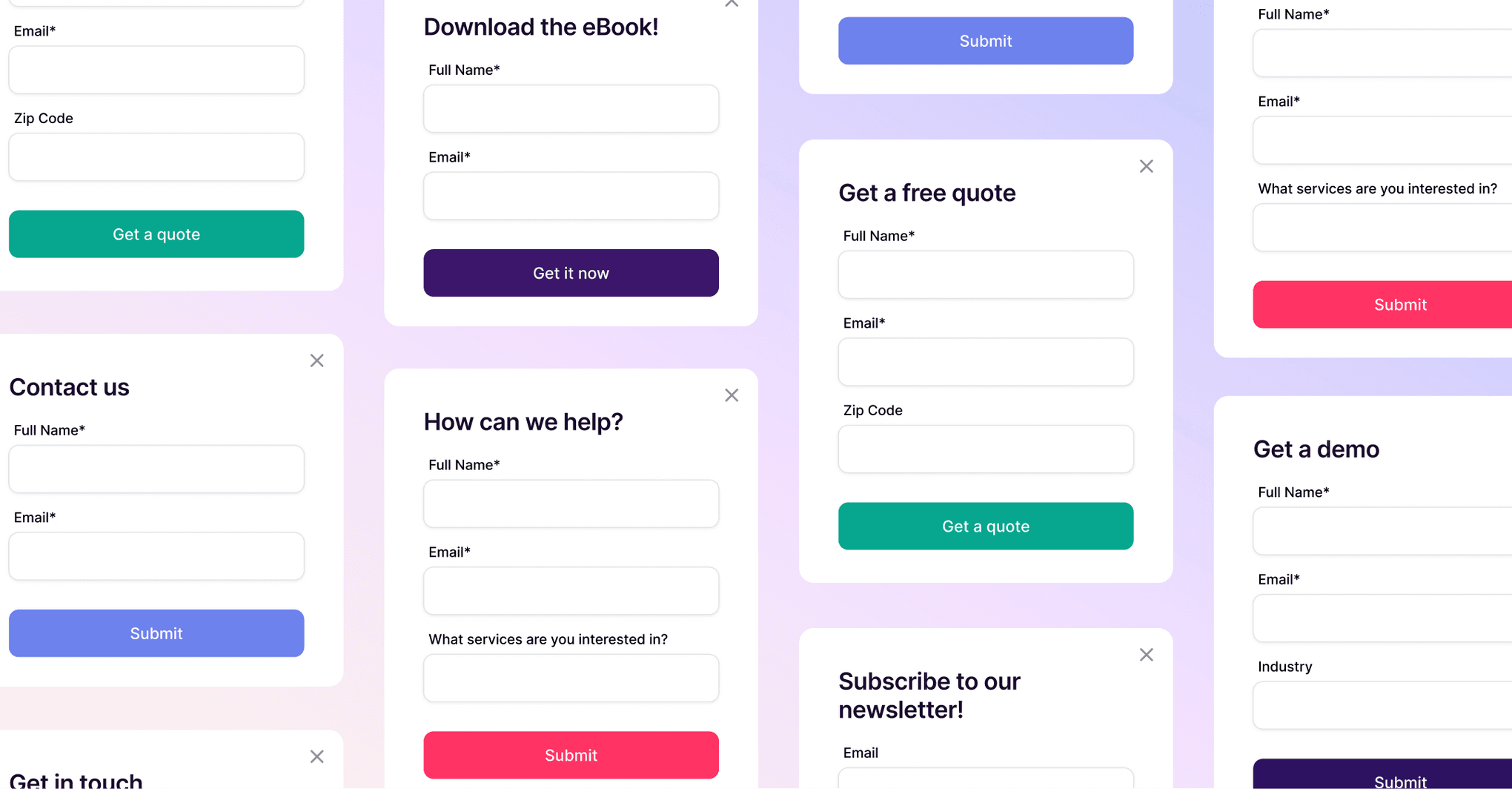Jemicah Marasigan
Content Marketing Manager
Financial services have always been about trust. People hand over their money, their plans for the future, and sometimes even their family’s security — expecting you to manage it with precision and care. No pressure, right?
But trust doesn’t scale well on spreadsheets. As client expectations grow, portfolios become more complex, and compliance rules multiply like rabbits, you need more than a sharp memory and sticky notes.
Enter the CRM for financial services.
In this guide, we’ll break down what makes a financial services CRM different, the features you can’t live without, how to evaluate options, and how to make sure your investment pays off.
What is a CRM for financial services and why it matters
A CRM for financial services is a software built for banks, advisors, and firms to manage client relationships, meet compliance needs, and deliver personalized service.
But, when it comes to finance, you’re not just keeping track of names and phone numbers: you’re managing sensitive financial data, navigating strict compliance rules, and keeping tabs on portfolios that seem to get more complex by the week.
A generic CRM wasn’t made for that. Instead of being “just another tool,” a financial services CRM is more like the command center of your firm. Picture it as:
Your digital filing cabinet. Every client record, document, and portfolio detail is stored securely in one place. No more digging through email threads or playing “which folder is it in this time?”
Your compliance sidekick. With audit trails, security features, and automated reporting, your CRM helps you stay on top of SEC and FINRA requirements without constant scrambling. Think of it as the system that remembers everything regulators care about — so you don’t have to.
Your growth engine. By automating reminders, keeping client journeys visible, and surfacing insights, a CRM helps you scale your relationships without adding more hours (or more sticky notes) to your day.
The beauty is that once it’s set up, it doesn’t feel like extra work. A good CRM runs quietly in the background, capturing everything you need, while you focus on what clients actually value — your advice, your judgment, and the trust you’ve built with them.
How a financial services CRM differs from a general business CRM
A standard CRM is fine for tracking leads and managing a pipeline. But financial services bring a level of complexity most CRMs aren’t built for.
Here’s why:
Compliance isn’t optional. SEC reporting, FINRA record-keeping, and industry audits require airtight record trails.
Relationships are layered. You’re often managing entire households, family offices, or multigenerational wealth plans.
Products are intricate. Insurance, investments, retirement accounts — each comes with unique workflows and data points.
In short: you need more than contacts and notes. You need context, compliance, and complexity built into your system.
Core capabilities that drive client relationship growth
A financial services CRM isn’t just a storage system. It’s the engine that helps you build trust, stay organized, and scale relationships without adding more hours to your day. When it’s working well, it makes client management feel less like juggling and more like momentum.
Here’s what that looks like in practice:
Segmenting clients effectively. Whether by net worth, product mix, or life stage, you can group clients in a way that makes your outreach feel tailored instead of generic. With Copper, these segments can also trigger automated workflows — like sending disclosures or scheduling reviews — so every client gets timely communication without you lifting a finger.
Tracking the client journey. Every conversation, review, and milestone lives in one place, so you always have the full story at your fingertips.
Automating compliance workflows. Disclosures, reminders, and reviews go out automatically, giving you peace of mind and freeing up your calendar.
Integrating with other tools. When planning and portfolio platforms connect directly with your CRM, you get a real-time, 360-degree view of every client.
The result? Less time spent on admin and more time strengthening relationships. With automation handling the repetitive stuff and integrations keeping everything connected, you can focus on the conversations and strategies that actually grow your clients’ trust (and your firm).
Who benefits most from a specialized financial services CRM?
It’s not just advisors who win when the right CRM is in place — the ripple effect touches every corner of the firm:
Advisors get one clear view of conversations, portfolios, and follow-ups, which makes it easier to stay on top of client needs.
Compliance officers rely on built-in audit trails and reporting that keep regulatory requirements from becoming a constant fire drill.
Operations managers spend less time on manual data entry and more time refining the processes that keep everything running smoothly.
Business development teams gain visibility into referral networks and opportunities that help fuel growth.
In short, a specialized CRM doesn’t just support one role — it strengthens the entire firm by making client management more seamless for everyone.
Essential CRM features every financial services firm needs
Here’s where you separate the “nice-to-have” extras from the “can’t-live-without” capabilities. These are the features that make a real difference in how effectively you can serve clients and scale your firm.
1. Client relationship management and family office capabilities
You’re not just tracking a single contact — you’re often managing households, trusts, and even multi-generational wealth. That means your CRM should support:
Household and family office management
Relationship mapping across accounts and entities
Rich client profiles that capture personal as well as financial context
2. Document management with security controls
From contracts to disclosures, you’re dealing with a steady stream of paperwork. A financial services CRM should give you a secure, searchable home for documents, with permissions that ensure the right people have the right access.
3. Advanced analytics and performance reporting
It’s not just about collecting data, it’s also about turning that data into insights. Look for features like advisor productivity dashboards, firm-wide KPIs, and customizable client reports. And since advisors aren’t always at their desks, mobile access is a must so you can pull up a profile on the go.
4. Mobile access for client meetings and field work
Advisors aren’t always tied to a desk, so your CRM needs to travel with you. A strong mobile app ensures you can pull up client details or portfolio data on the spot — whether you’re at a lunch meeting, in transit, or working from home.
Bonus points if the app includes offline features, so you’re never caught empty-handed when Wi-Fi drops.
Integration capabilities that streamline your financial services workflow
Here’s the truth: if your CRM can’t talk to the rest of your tech stack, it’s going to feel like more of a burden than a solution.
The whole point of a CRM for financial services is to cut down on busywork, not create more of it.
That’s why integration isn’t just a “nice-to-have” — it’s the glue that holds your client management ecosystem together.
Think about all the tools you’re already using every day:
Financial planning software
Whether it’s Orion, eMoney, MoneyGuidePro, or another planning platform or API option, your CRM should plug right in so financial plans and client conversations live in the same place instead of two disconnected silos
Email and calendar platform integration
If you live in Gmail and Google Calendar, your CRM should too. Automatic logging of every email and meeting keeps the client story intact without you having to remember to “update the system later.”
Document storage and sharing platform connections
Contracts, disclosures, statements: they all pile up fast. By connecting with Google Drive or Dropbox, your CRM becomes the one-stop shop for securely accessing what you need, when you need it.
Google Workspace connectivity
This is where Copper really stands out.
Because it’s built natively for Google Workspace, you don’t just integrate with Gmail, Docs, and Sheets — you actually work inside them.
The CRM runs quietly in the background, automatically capturing and organizing emails, files, and calendar events. That means fewer app switches, fewer missed updates, and more time to focus on the client in front of you instead of chasing down information.
Get the latest from our blog every month
How to evaluate and compare CRM options for your financial practice
Picking a CRM for financial services can feel overwhelming. There are so many platforms out there, each promising to “streamline everything” and “transform your client experience.”
But here’s the secret: the right CRM isn’t about buzzwords — it’s about fit.
Fit for your workflows, your compliance needs, and your growth plans. Think of this process as your CRM “fit test,” and walk through it step by step.
Step 1: Define your specific business and client needs
Before you even start looking at vendors, get clear on what you actually need the CRM to do.
Are compliance tasks slowing you down?
Is data scattered across email, spreadsheets, and sticky notes?
Do advisors waste time chasing the same information in three different places?
Talk to the people who use these systems every day — advisors, compliance officers, ops teams — and map out their workflows. This way, when you start comparing CRMs, you’ll know exactly which features are essential and which are just window dressing.
Step 2: Assess vendor experience in financial services
Not all CRMs are created equal, and plenty were designed with retail or general sales in mind. Financial services come with a whole different level of complexity and your vendor should understand that.
Look for CRMs with industry certifications, financial sector case studies, or existing clients similar to your firm. If a vendor “gets” the industry, you won’t spend months begging them for features they should’ve had in the first place.
Step 3: Test integration capabilities with existing tools
Every vendor will tell you, “Yes, we integrate.” But don’t just take their word for it, test how the CRM works with your portfolio management system, financial planning software, and everyday tools like Google Workspace.
If syncing feels clunky or information doesn’t flow both ways, that’s a red flag. A CRM should make your day smoother, not add extra clicks and headaches.
Step 4: Evaluate scalability for business growth
Right now, your firm might have 12 advisors in a single office. But what happens when you double your headcount? Or open a second location? A good CRM grows with you.
Look for platforms that can handle increasing users, larger data loads, and multi-office support without breaking down or forcing an expensive system overhaul later.
Step 5: Verify security and compliance certifications
This part isn’t glamorous, but it’s critical. You’re handling sensitive financial data, and regulators expect airtight systems. Don’t settle for vague reassurances. Ask for proof of industry-specific certifications that show the CRM can handle SEC and FINRA requirements.
Because at the end of the day, no feature is worth risking client trust and security is what protects it.
Understanding costs and ROI when selecting a financial services CRM
CRMs can feel expensive, but losing clients because of missed follow-ups or compliance mistakes costs a lot more. The key is to look past the subscription fee and consider both the true cost and the long-term return.
Common pricing models and what they include
Most CRMs charge per user, often with tiered plans.
Higher tiers unlock features like compliance tools or advanced analytics, while larger firms may need enterprise agreements with added security and multi-office support.
Calculating total cost of ownership beyond software fees
The price tag is just the start. Factor in implementation, training, integrations, and ongoing support to get the real cost of ownership.
Measuring ROI through client retention and acquisition
A good CRM should quickly earn its keep by helping you retain more clients, win new ones, and grow assets under management (AUM).
Avoiding hidden implementation and maintenance costs
Ask vendors upfront about migration, customization, or compliance add-on fees. Knowing the full scope saves you from budget surprises later.
Best practices for successful CRM implementation in financial services
Even the best CRM can flop if it isn’t rolled out thoughtfully. Implementation is about more than turning the system on — it’s about setting your team up for success. Below are a few key steps to guide the process (and yes, a simple checklist visual would work beautifully alongside this section).
Creating an implementation timeline and milestones
Treat your CRM rollout like a project, not an afterthought. Build a clear plan with realistic target dates, then roll out the system in phases instead of flipping the switch overnight. A staged approach helps your team adjust gradually and gives you the chance to spot and fix problems before they escalate.
Developing effective data migration strategies
“Garbage in, garbage out” couldn’t be truer when it comes to CRMs. Before importing data, take the time to clean, validate, and test it. Map your data carefully, run test migrations, and check for errors before committing fully. Starting fresh with clean, accurate data builds trust in the new system right away.
Building team adoption through proper training
Don’t just hand over logins and hope your team figures it out. Create structured onboarding sessions that walk users through daily workflows in the CRM. Appoint a few “CRM champions” (power users who can answer questions and help peers along the way).
And don’t forget to leverage vendor resources here. Many CRM providers offer guided onboarding, training sessions, or even dedicated account managers to make adoption smoother and shorten the learning curve.
Managing change and maintaining productivity during transition
Technology is only half the battle — the other half is people.
A clear change management plan helps reduce resistance and keep morale high. Communicate openly about why the CRM is being introduced, how it will make work easier, and what support is available during the transition.
Track productivity as you roll out new processes to make sure the team stays on track.
Handled this way, CRM implementation feels less like a disruption and more like a step forward — one that gives your team the tools, confidence, and support they need to thrive.
Measuring CRM success and optimizing client relationships
Once your CRM is live, the question becomes: is it actually working for you?
Success isn’t just about having cleaner data, it’s about proving that the system is helping you win more clients, keep the ones you have, and run your firm with less friction.
Key performance indicators for a financial services CRM
KPIs are your reality check. A good CRM should help you bring in new clients, improve satisfaction scores, and keep compliance tasks from slipping through the cracks.
If those numbers are moving in the right direction, you’ll know the system is doing more than just sitting quietly in the background.
Tracking client satisfaction and retention metrics
Happy clients stick around — and in financial services, retention is everything. Use surveys, NPS scores, and simple feedback loops to capture how clients feel about working with you.
Then track retention rates to see if those positive feelings actually translate into loyalty. If you’re losing clients despite high scores, it’s a cue to dig deeper.
Monitoring productivity gains and efficiency improvements
One of the biggest selling points of a CRM is time. Are advisors spending fewer hours on manual updates? Can they handle more accounts without burning out?
Look at how much admin time is shrinking and how much advisor capacity is growing. If the CRM isn’t freeing people up to focus on clients, it’s not pulling its weight.
Using analytics to identify growth opportunities
The smartest CRMs don’t just help you manage today’s business, they point you toward tomorrow’s. Dive into analytics to spot cross-sell and upsell opportunities, track referral patterns, and measure expansion across households or offices.
These insights turn your CRM from a digital filing cabinet into an actual growth engine.
Start building stronger client relationships with the right CRM solution
The best financial services CRM doesn’t just tick the compliance box. It strengthens trust, streamlines workflows, and gives you the freedom to grow without drowning in admin tasks.
Copper makes this easier with native Google Workspace integration, automation that eliminates busywork, and intuitive workflows designed to keep advisors focused on what matters most — building lasting client relationships.
Ready to see the difference for yourself? Try Copper free for 14 days and experience how effortless client management can be.






